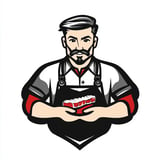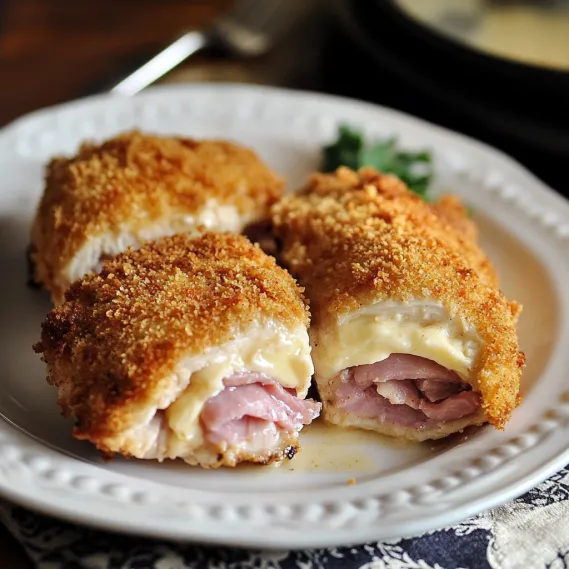 Pin it
Pin it
There's a real magic to easy-to-make Chicken Cordon Bleu. This smart approach gets rid of the usual hassles by simply cutting a pocket in the chicken breast to tuck away the ham and cheese. No more struggles with chicken that rips or cheese that explodes during cooking. You'll get everything you want - juicy tender chicken, tasty ham, and gooey Swiss cheese - all wrapped in a crunchy, butter-rich outer layer that makes every bite absolutely mouthwatering.
I'd almost thrown in the towel on making chicken cordon bleu at home after too many kitchen fails leaving me with broken chicken and cheese puddles everywhere. Then I found this trick. When I made it for friends last month, a caterer in the group asked how I did it, saying it looked store-bought fancy - that's when I knew I'd found a can't-fail approach.
Key Ingredients and Smart Shopping Advice
- Chicken Breasts: Go for big, chunky (8-ounce minimum) boneless skinless pieces. You need the extra thickness to make a good pocket that won't tear
- Ham: Pick thin-cut deli ham that folds easily. If your slices are on the small side, just overlap a couple to make enough room for the cheese
- Swiss Cheese: The shredded kind works better than slices for this dish - it rolls up nicer in the ham and melts more evenly
- Ritz Crackers: These buttery crackers take the coating to another level. Sure, plain breadcrumbs work fine, but Ritz adds that special buttery taste that makes this dish stand out
Good ingredients matter for sure, but it's really the method that changes everything. After trying the hard way for so long, this pocket trick has turned a fancy restaurant dish into something I can make on a random Tuesday night.
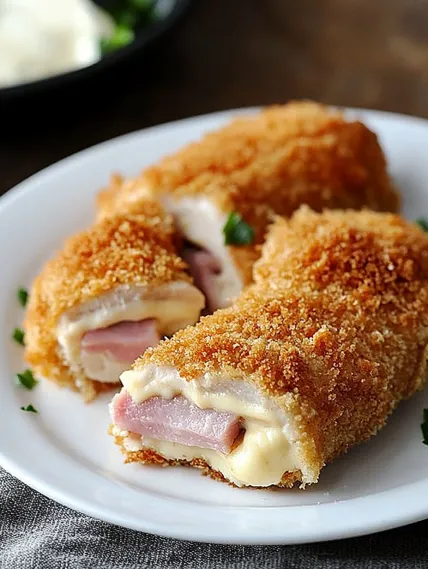 Pin it
Pin it
Simple Step-by-Step Cooking Method
- Step 1: Make Your Crunchy Coating
- Crush 25 Ritz crackers and 4 slices of thick sandwich bread in your food processor until they're roughly ground, then slowly add 6 tablespoons melted butter while pulsing. Spread this mix on a baking sheet and toast at 450°F for 3-5 minutes until it turns slightly golden, giving it a stir now and then. Move it to a shallow dish and turn your oven down to 400°F.
- Step 2: Roll Up Your Ham and Cheese
- Lay out 8 thin ham slices and put about 1/4 cup shredded Swiss on each one. Roll the ham tightly around the cheese to make little bundles that'll fit in your chicken. If your ham is on the small side, just overlap a couple slices to make a bigger piece, making sure the cheese stays totally wrapped up.
- Step 3: Get Your Chicken Ready
- Dry your chicken breasts with paper towels, then use a sharp knife to cut a deep 3-4 inch pocket in the thickest part. Don't cut all the way through or too close to the edges. Gently push two ham-cheese rolls into each pocket, then close the flap and press it down. If needed, secure with a toothpick, then sprinkle salt and pepper on both sides.
- Step 4: Coat Your Chicken
- Set up three dishes: one with flour, one with beaten eggs mixed with Dijon mustard, and one with your toasted crumb mix. Roll each stuffed chicken breast in flour first, then into the egg mixture, and finally into the crumbs, pressing gently so they stick. Put your breaded chicken on a lightly oiled baking sheet.
- Step 5: Bake It Up
- Bake your chicken in the 400°F oven until it's golden brown and reaches 160°F inside, around 25-30 minutes. Let it rest for 5 minutes before cutting in - this lets the juices settle and the cheese firm up a bit. Take out any toothpicks before serving so it looks nice.
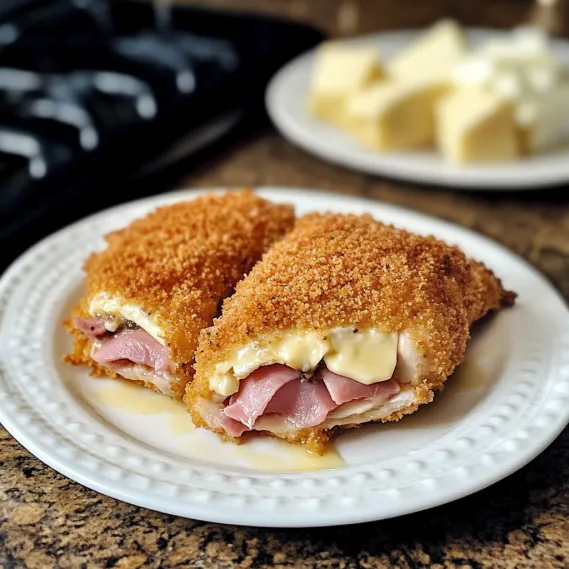 Pin it
Pin it
The first time I tried this pocket method, I couldn't believe how much easier it was than the old way. No more pounding chicken until it falls apart, no more fighting with toothpicks, and best of all, no more cheese blowouts in the oven. This approach keeps everything neat and tidy while giving you all the fantastic flavors that make chicken cordon bleu so popular.
Delicious Serving Ideas
This chicken cordon bleu goes great with sides that balance its rich taste. For a fancy dinner, try it with oven-roasted asparagus and creamy mashed potatoes. The crispy asparagus gives you a nice texture contrast, while the potatoes are perfect for soaking up the yummy juices. If you want something lighter, a fresh spinach salad with candied nuts and apple slices cuts through the richness of the chicken nicely.
Prep-Ahead Possibilities
One thing I love about this dish is you can get it ready ahead of time. You can stuff the chicken and keep it in the fridge for several hours before adding the coating, which is super handy when you've got company coming. You can even bread the chicken up to a day ahead and keep it covered in the fridge until you're ready to cook. This means you can do the prep work when it's convenient and just pop it in the oven before dinner.
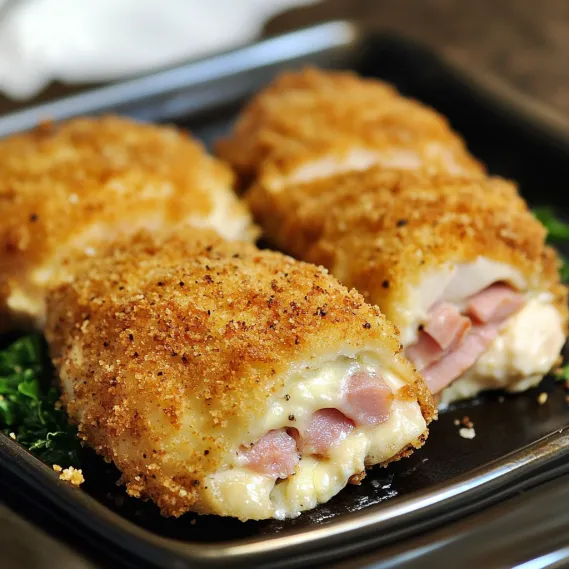 Pin it
Pin it
Fixing Common Problems
If you're worried about your chicken cooking evenly, especially with really thick pieces, you can loosely cover the pan with foil halfway through if the coating is getting too brown. For the best results, try to use chicken breasts that are all about the same size. If they're really different sizes, you might need to take the smaller pieces out early while letting the bigger ones cook a bit longer.
This Chicken Cordon Bleu has become my favorite for family dinners and when friends come over. The pocket trick turns what used to be a kitchen nightmare into something I actually look forward to making. The mix of the crispy outside, tender chicken, and perfect ham and cheese inside makes a dish that looks fancy but is way easier than the traditional version. Sometimes the smartest cooking hacks make classic dishes even better than the original.
Frequently Asked Questions
- → How far ahead can I prep this dish?
- Go ahead and prepare the chicken up to the breading step. Cover it and keep it in the fridge for up to a day before baking. This extra time actually makes the crumbs stick better and reduces cheese bubbling out. Add 5 more minutes in the oven if cooking straight from the fridge. Or you can freeze the uncooked chicken (still breaded) for a month. Just thaw it in the fridge overnight before baking.
- → What sides pair well with this chicken?
- This dish goes great with lots of sides! Classic options include buttered noodles, rice, or simple greens like broccoli or asparagus. A tossed salad with a light dressing is always a winner too. For something heartier, mashed or roasted potatoes hit the spot. And don't forget, a drizzle of Dijon cream sauce or a light gravy makes any side even more tasty.
- → Can I customize the fillings?
- Totally! The traditional version uses Swiss cheese and ham, but feel free to get creative. Provolone, mozzarella, or Gruyère work well, and for meat, prosciutto or even smoked turkey are great swaps. Want an Italian twist? Throw in mozzarella with prosciutto and a basil leaf for a fun combo. Just make sure you use similar amounts to keep it balanced.
- → Why does my cheese keep leaking out?
- It's super common, but these tips should help: Use larger chicken breasts and cut a deep pocket instead of slicing through. Let the stuffed chicken chill before breading, so it seals better. Don’t overfill with cheese, and secure the seam with toothpicks if you have to. Lastly, keep the oven at the right temperature – too hot can make the cheese ooze out faster than the chicken cooks.
- → Is it possible to make this gluten-free?
- Yes! Swap the breadcrumbs and crackers with gluten-free alternatives and use gluten-free flour for breading. The chicken won’t be as crunchy, but the flavor stays spot on. Double-check that your Dijon mustard is gluten-free – some brands sneak in gluten.
- → How do I tell when it's done?
- Use a meat thermometer for the best results. Stick it into the thickest part (but not the filling), and when it reads 165°F, you're good. If you don’t have one, cut into the thickest chicken piece. It should look fully white with no pink, and the juice should run clear.
